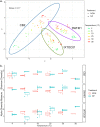Hydrocarbon-Degrading Microbial Communities Are Site Specific, and Their Activity Is Limited by Synergies in Temperature and Nutrient Availability in Surface Ocean Waters
- PMID: 31126938
- PMCID: PMC6643229
- DOI: 10.1128/AEM.00443-19
Hydrocarbon-Degrading Microbial Communities Are Site Specific, and Their Activity Is Limited by Synergies in Temperature and Nutrient Availability in Surface Ocean Waters
Abstract
The objective of this study was to quantify the potential for hydrocarbon biodegradation in surface waters of three sites, representing geographic regions of major oil exploration (Beaufort Sea in the Arctic, northern Gulf of Mexico [GOM], and southern GOM), in a systematic experimental design that incorporated gradients in temperature and the availability of major nutrients. Surface seawater was amended in microcosms with Macondo surrogate oil to simulate an oil slick, and microcosms were incubated, with or without nutrient amendment, at temperatures ranging from 4 to 38ºC. Using respiration rate as a proxy, distinct temperature responses were observed in surface seawater microcosms based on geographic origin; biodegradation was nearly always more rapid in the Arctic site samples than in the GOM samples. Nutrient amendment enhanced respiration rates by a factor of approximately 6, stimulated microbial growth, and generally elevated the taxonomic diversity of microbial communities within the optimal temperature range for activity at each site, while diversity remained the same or was lower at temperatures deviating from optimal conditions. Taken together, our results advance the understanding of how bacterioplankton communities from different geographic regions respond to oil perturbation. A pulsed disturbance of oil is proposed to favor copiotrophic r-strategists that are adapted to pointed seasonal inputs of phytoplankton carbon, displaying carbon and nutrient limitations, rather than oil exposure history. Further understanding of the ecological mechanisms underpinning the complex environmental controls of hydrocarbon degradation is required for improvement of predictive models of the fate and transport of spilled oil in marine environments.IMPORTANCE The risk of an oil spill accident in pristine regions of the world's oceans is increasing due to the development and transport of crude oil resources, especially in the Arctic region, as a result of the opening of ice-free transportation routes, and there is currently no consensus regarding the complex interplay among the environmental controls of petroleum hydrocarbon biodegradation for predictive modeling. We examined the hydrocarbon biodegradation potential of bacterioplankton from three representative geographic regions of oil exploration. Our results showed that rates of aerobic respiration coupled to hydrocarbon degradation in surface ocean waters are controlled to a large extent by effects of temperature and nutrient limitation; hydrocarbon exposure history did not appear to have a major impact. Further, the relationship between temperature and biodegradation rates is linked to microbial community structure, which is specific to the geographic origin.
Keywords: biodegradation; hydrocarbons; microbial communities; nutrients; oil; temperature.
Copyright © 2019 American Society for Microbiology.
Figures



Similar articles
-
The Interactive Effects of Crude Oil and Corexit 9500 on Their Biodegradation in Arctic Seawater.Appl Environ Microbiol. 2020 Oct 15;86(21):e01194-20. doi: 10.1128/AEM.01194-20. Print 2020 Oct 15. Appl Environ Microbiol. 2020. PMID: 32826215 Free PMC article.
-
Inter- and Intra-Annual Bacterioplankton Community Patterns in a Deepwater Sub-Arctic Region: Persistent High Background Abundance of Putative Oil Degraders.mBio. 2021 Mar 16;12(2):e03701-20. doi: 10.1128/mBio.03701-20. mBio. 2021. PMID: 33727364 Free PMC article.
-
Biodegradation of dispersed Macondo crude oil by indigenous Gulf of Mexico microbial communities.Sci Total Environ. 2016 Jul 1;557-558:453-68. doi: 10.1016/j.scitotenv.2016.03.015. Epub 2016 Mar 24. Sci Total Environ. 2016. PMID: 27017076
-
Biodegradation of marine oil spills in the Arctic with a Greenland perspective.Sci Total Environ. 2018 Jun 1;626:1243-1258. doi: 10.1016/j.scitotenv.2018.01.173. Epub 2018 Feb 19. Sci Total Environ. 2018. PMID: 29898532 Review.
-
A Review and Bibliometric Analysis on Applications of Microbial Degradation of Hydrocarbon Contaminants in Arctic Marine Environment at Metagenomic and Enzymatic Levels.Int J Environ Res Public Health. 2021 Feb 9;18(4):1671. doi: 10.3390/ijerph18041671. Int J Environ Res Public Health. 2021. PMID: 33572432 Free PMC article. Review.
Cited by
-
Genome-resolved analyses show an extensive diversification in key aerobic hydrocarbon-degrading enzymes across bacteria and archaea.BMC Genomics. 2022 Oct 6;23(1):690. doi: 10.1186/s12864-022-08906-w. BMC Genomics. 2022. PMID: 36203131 Free PMC article.
-
Methylotrophs and Hydrocarbon-Degrading Bacteria Are Key Players in the Microbial Community of an Abandoned Century-Old Oil Exploration Well.Microb Ecol. 2022 Jan;83(1):83-99. doi: 10.1007/s00248-021-01748-1. Epub 2021 Apr 17. Microb Ecol. 2022. PMID: 33864491
-
Bacterial response to the 2021 Orange County, California, oil spill was episodic but subtle relative to natural fluctuations.Microbiol Spectr. 2025 Mar 14;13(5):e0226724. doi: 10.1128/spectrum.02267-24. Online ahead of print. Microbiol Spectr. 2025. PMID: 40084855 Free PMC article.
-
The Interactive Effects of Crude Oil and Corexit 9500 on Their Biodegradation in Arctic Seawater.Appl Environ Microbiol. 2020 Oct 15;86(21):e01194-20. doi: 10.1128/AEM.01194-20. Print 2020 Oct 15. Appl Environ Microbiol. 2020. PMID: 32826215 Free PMC article.
-
Microorganisms that produce enzymes active on biodegradable polyesters are ubiquitous.Biodegradation. 2023 Dec;34(6):489-518. doi: 10.1007/s10532-023-10031-8. Epub 2023 Jun 24. Biodegradation. 2023. PMID: 37354274 Review.
References
-
- Farrington JW. 2013. Oil pollution in the marine environment. I. Inputs, big spills, small spills, and dribbles. Environ Sci Policy Sustain Dev 55:3–13. doi:10.1080/00139157.2013.843980. - DOI
-
- Barbier CJ. 2015. MDL 2179 oil spill by the oil rig “Deepwater Horizon.” http://www.laed.uscourts.gov/sites/default/files/OilSpill/Orders/1152015....
-
- Ryerson TB, Camilli R, Kessler JD, Kujawinski EB, Reddy CM, Valentine DL, Atlas E, Blake DR, de Gouw J, Meinardi S, Parrish DD, Peischl J, Seewald JS, Warneke C. 2012. Chemical data quantify Deepwater Horizon hydrocarbon flow rate and environmental distribution. Proc Natl Acad Sci U S A 109:20246–20253. doi:10.1073/pnas.1110564109. - DOI - PMC - PubMed
Publication types
MeSH terms
Substances
LinkOut - more resources
Full Text Sources
Other Literature Sources

